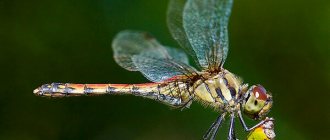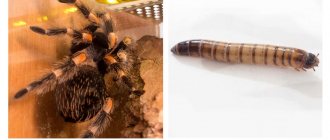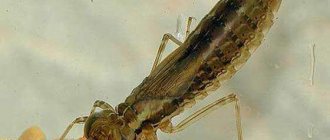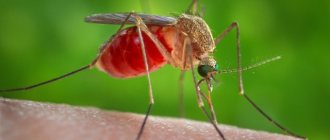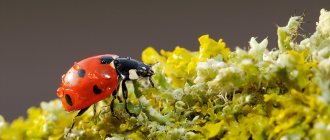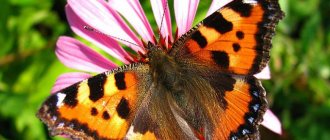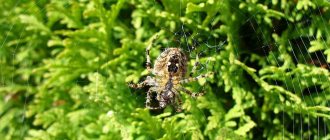Class Insects (Insecta)
Class Insects (Insecta). Structural features, digestion, respiratory and excretory systems, sensory organs and representatives
The most numerous class among the animal kingdom. There are over 1 million species (more than the species of plants and other animals combined). They live mainly on land, in the soil, and fly in the air. Some species have adapted to life in water, a parasitic lifestyle. Sizes range from a few millimeters to 25 cm (the wingspan of some species of tropical butterflies). The lifespan of adult insects is short (approximately several months). At the same time, some species can live for several years (female ants and termites - up to 20 years). The branch of zoology that studies insects is called entomology (from the Greek entomon - insect and logos - science). Possible ancestors of insects are centipedes.
The cuticle of insects is covered with a thin layer of fat-like substance that prevents the body from losing moisture. On the surface of the cuticle there are movable hairs, scales, and bristles.
The body consists of a head, chest and abdomen. On the head there are a pair of segmented antennae, oral organs (a pair of upper jaws, a pair of lower jaws, a lower lip), a pair of complex compound eyes, and maybe 1 - 3 simple ocelli. The area between the compound eyes is called the forehead . On the sides under the eyes there are cheeks . The back surface of the head is called the occiput . The head and thoracic region are movably connected.
The chest consists of three segments. They have 3 pairs of limbs that extend from each thoracic segment and are movably attached. The types of limbs depend on the lifestyle: walking, running (in beetles), hock (in grasshoppers), digging (in mole crickets), swimming (in the diving beetle). On the last segment of the legs there are claws, and in some species there are also suckers.
Many insects (adults only) have wings (a fold of skin filled with hemolymph) that are attached to the second or second and third segments of the thorax. The wings have developed transverse and longitudinal veins that form a supporting frame. The trachea and nerves pass through the middle of the veins. The shape and structure of the wings are varied. In many species, the first pair of wings is transformed into hard elytra that protect the rear membranous, often transparent wings from damage. In the order Diptera only the first pair of wings is developed. The second is modified into club-shaped appendages, which provide a certain frequency of wing flaps, stabilize the insect’s balance in flight and are called halteres . There are two known types of flight in insects: flapping and soaring. Flight is ensured by the coordinated work of the pectoral and wing muscles. By quickly working their wings, some insects are able to hover in the air (flies, dragonflies, etc.).
The abdomen consists of several segments (4 – 10) and an anal plate. It houses most of the internal organs. Each segment has a pair of spiracles. There are no limbs. In some species they are modified into an ovipositor, sting, etc. The paired appendages of the last abdominal segment are called cerci.
↑ Insectivorous mammals
Insectivorous animals include primitive placental mammals, the chordate type. Their embryos develop in the resulting placenta. More often they are omnivores that eat small vertebrates (insects) and parts of plants.
Hedgehogs and shrews are land dwellers, otter shrews and muskrats like the aquatic environment, moles and golden moles like to live in burrows. Hedgehogs sleep in winter, buried in old leaves and grass. Tenrecs with spines like hedgehogs are of interest. They are characterized by low body temperature.
gaptooth photo
Snaptooths are similar to shrews, but larger. These are poisonous mammals. African insectivores are jumpers, similar to jerboas.
Digestive system of insects
Class Insects (Insecta). Types of mouthparts: gnawing type (grasshopper), sucking type (butterfly) and licking type (fly)
The nature of their diet is varied (predators, parasites, herbivores, etc.). The structure of the oral apparatus is associated with the type of food and lifestyle. There are several types of mouthparts.
The gnawing mouthparts are considered the most ancient (characteristic of primitive insects) and are common in insects that feed on solid plant or animal food (beetles, cockroaches, orthoptera, etc.). On top, the oral opening of such an apparatus is covered by an unpaired plate (upper lip), on the sides there are paired upper and lower jaws, and on the bottom – an unpaired lower lip. The upper lip is formed by a fold of the cuticle. The upper jaws are represented by plates with teeth on the inside. The lower jaws consist of two segments. On the upper segment there is a pair of ruminant lobes and a mandibular dissected palp (the organ of touch and taste). The lower lip was formed by the fusion of the lower jaws, consists of two segments and has a pair of lower labial palps and two pairs of ruminant lobes.
The piercing-sucking apparatus is characteristic of insects (bugs, mosquitoes, etc.) that feed on liquid food: plant juice, tissue, animal blood.
A sucking mouthpart in the form of a long tube of two halves is found in butterflies that feed on the juice of fruits and the nectar of flowers. Flies have a peculiar oral apparatus with a fleshy lower lip - licking (modified sucking).
Gnawing-licking mouthparts are found in Hymenoptera (bees, wasps, etc.). These are mouthparts that have extended into a proboscis to suck up nectar. At the same time, the upper jaws remained almost unchanged (reduced ruminant teeth) and are used for the structure of cells. Sometimes adult insects do not feed (mulberry moths), their oral organs do not function and may be reduced.
The digestive system consists of the oral cavity, pharynx, esophagus, large crop, muscular stomach (in insects that feed on solid food, the walls are thick with chitinous teeth or plates for grinding food), midgut, hindgut, which ends in the anus.
The ducts of the salivary glands open into the oral cavity. Their secretion moistens and partially dissolves solid food. In bees, the secretion of the salivary glands turns into honey when mixed with nectar. In the caterpillars of butterflies, hymenoptera larvae and some other insects, the salivary glands are modified into silk-secreting or spinning glands. Silk thread is used to build a cocoon, protective formations, etc.
Worker bees feed the larvae of the future queen with the secretion of the pharyngeal glands.
The inside of the midgut is lined with glandular epithelium, which secretes digestive juice. Insects do not have a liver. Some insects, like spiders, are capable of extraintestinal digestion (ladybug larvae, diving beetles, etc.).
Silkworm
We have silkworms to thank for the silk items in our wardrobes. The caterpillars of these butterflies produce silk. More precisely, silk fiber from which the insect builds its cocoon. One larva is capable of producing 15 cm of mulberry in a minute. And in the cocoon of this thread there can be about a kilometer.
The silkworm is unknown in the wild; it was domesticated several thousand years ago in China.
Other types of silkworms are sometimes bred, but they produce fiber of poorer quality.
Respiratory system of insects
They breathe using the trachea. They branch and entwine all organs, even entering individual cells in the form of tracheoles. stigmas open outwards - openings on the sides of the abdomen and chest. In the anterior part of the abdomen and chest, the trachea expands and forms air sacs. Gas exchange occurs through the trachea (oxygen is absorbed, carbon dioxide is removed), and water vapor is removed. Breathing occurs due to the rhythmic contraction and stretching of the lateral and longitudinal muscles of the abdomen. The larvae of some insects breathe using tracheal gills (dragonflies, mayflies). These are formations on the surface of the body or in the hindgut, which have the appearance of petals with branched trachea in the middle. The tracheal system is closed (there are no spiracles). Oxygen enters the trachea from the gills.
Development
Insects begin their life with eggs, the appearance and shape of which are very diverse. Eggs are also laid in different ways: one at a time, in groups, openly, immersed in the substrate or covered in various ways. The variety of egg shapes and means of laying them even makes it possible to identify certain groups of insects with precision down to genus and species. The embryonic development of insects occurs in the egg, resulting in the formation of a larva. The larva emerges from the egg shell in one way or another. She eats and grows, but only grows when she molts.
Incomplete development: locusts
The transformation of a larva into an adult is called metamorphosis. There are two main types of development - incomplete and complete. When metamorphosis is incomplete, the eggs hatch into larvae that look like smaller copies of adults. The only difference is that they do not have a reproductive system and only the rudiments of wings. During molts, they grow and, bypassing the pupal stage, turn into adults. With complete metamorphosis, the larva first turns into a pupa, and only then into an adult. There are three main types of pupae:
- open or free
- covered, covered with a hard shell
- hidden, covered with hardened, not shed skin, which acts as a false cocoon.
Before turning into a pupa, the larva can form a cocoon of silk, like silkworms; The pupae of daytime butterflies are often not covered with anything. Other insects, on the eve of pupation, look for some kind of shelter: cracks under the bark, rolled up leaves, or bury themselves in the ground. Many insects have immobile pupae. Mosquito pupae swim well, and lacewing pupae crawl. Under the shell of the pupa, complex transformations occur, as a result of which the organs of the imago are formed.
Nervous system of insects
It consists of the subpharyngeal (formed by the fusion of three ganglia) and suprapharyngeal ganglia, connected by peripharyngeal connectives, and the ventral nerve chain. The subpharyngeal node innervates the oral organs and the anterior intestine. The ventral chain is formed by three thoracic ganglia and eight abdominal ones. In some highly organized insects, adjacent nodes of the ventral nerve chain merge by combining the thoracic ganglia into one large node. The abdominal nodes can merge into 2 - 3 or 1 large node (in flies, lamellar beetles). The thoracic ganglia regulate the functioning of the legs and wings.
The suprapharyngeal ganglion forms a special development. It forms the brain, which includes three sections: anterior, middle and posterior. Innervates the antennae and eyes (it has a pair of large optic lobes on the sides). stalked or mushroom-shaped are very well developed . They are believed to be responsible for the behavior of insects.
The complex structure of the nervous system causes complex behavior.
↑ Nocturnal insectivorous birds and animals
Nocturnal animals that hunt at night have sensitive hearing and a keen sense of smell, and their eyes are adapted to see in the dark. What makes these animals nocturnal?
- It's not as hot at night as during the day.
- Competition for food decreases.
- Luck in hunting increases.
- The danger from predators is reduced.
Night hunters include the nightjar, eagle owl and owl, the omnivorous raccoon and the red-eyed tree frog. Also hedgehogs, lemurs, bats and other animals.
Sense Organs of Insects
On the head there is 1 pair of antennae (organs of smell and touch). Various structure of the antennae: comb-shaped, club-shaped, filamentous, lamellar, bristle-shaped, serrated, etc. The organ of vision is complex (compounded) eyes, sometimes there are simple ones (1 – 3). Each compound eye consists of a large number of facets (several thousand). Most insects do not perceive red color, but they perceive ultraviolet radiation well. Simple eyes (not capable of perceiving images) react to the degree of illumination and can perceive polarized light. Insect larvae with complete metamorphosis have lateral eyes (from one to several pairs). Each such eye can perceive images of objects. The body and limbs are covered with hairs and scales, which are receptors for taste, touch, etc. Some insects have a hearing organ (in grasshoppers, on the front pair of legs, etc.).
Dragonfly
At least once in their life, every person has looked at this insect. Particularly attractive are the beautiful iridescent wings and the mask on the head. When you see a powerful retractable jaw, the question does not arise: is a dragonfly a predatory insect or not?
This is a fast flying predator. Lives near bodies of water. Leads a mostly solitary lifestyle. It feeds on mosquitoes, small flies and bugs. Pursuing the victim, it is capable of accelerating up to eighty kilometers per hour. With tenacious paws it grabs the victim in flight and deals with it with the help of its powerful jaw. Dragonflies differ in the shape of their wings, the location of the aircraft and the length of the body, but in all of them the larva leads a long aquatic lifestyle. Some species spend more than five years in this stage. The dragonfly larva is a predatory insect of water bodies. Sedentary, but very voracious. It feeds on mosquito larvae, beetles and fry. The long-winged beauty itself is subject to attacks by fish, birds and large insects. Therefore, the number of dragonflies is not so large.
Insect Reproduction
Types of insect development. Complete transformation (development with metamorphosis) and incomplete transformation (development without metamorphosis)
They reproduce only sexually (with or without fertilization). Reproductive organs are developed only in adult insects (imago). Insects are dioecious. In many species, sexual dimorphism is well expressed (beetle - deer, butterflies, etc.). The genital organs are located in the abdomen. In females they are represented by tubular ovaries, oviducts, accessory gonads, and spermatic receptacle. At the end of the abdomen, females have an ovipositor for laying eggs. In some insects of the order Hymenoptera, it is turned into a sting with a duct of a poisonous gland inside.
In males, the reproductive system is represented by a pair of testes, vas deferens, vas deferens, and accessory reproductive organs. At the end of the abdomen the copulatory apparatus may be developed. Fertilization is predominantly internal.
There is only one genital opening, since the ducts of the gonads merge. Some insects are characterized by mating behavior (competition for a female, etc.).
Most insects lay eggs, sometimes they are viviparous (they give birth to live larvae - aphids, gadflies, etc.). Eggs are covered with a thick shell and contain a supply of nutrients (yolk) inside. They are laid by females singly or in groups on different surfaces, in soil, water or in animals, etc. The insects are very prolific (bees lay up to 1.5 million eggs every day for 10 - 12 years; termite queen - over 30 thousand eggs) . They can have several generations per year (depending on the species and living conditions).
Development with transformation (complete and incomplete). Stages of incomplete transformation : egg - larva - adult insect ( imago ). Characteristic of cockroaches, bedbugs, lice, orthoptera, etc. Insect larvae with incomplete metamorphosis are similar in appearance to an adult insect, but are smaller in size (after each molt they become more and more similar to an adult), primarily live where adults live, and feed on the same food. food. Sometimes the larvae live in a different environment (dragonflies, etc.), then they have certain adaptations and differ somewhat from adult insects.
Stages of complete transformation : egg - larva - pupa - adult insect (imago). Characteristic of Lepidoptera, Hardy Ptera, Hymenoptera, Diptera, etc. The larva is neither in appearance nor in its way of life similar to an adult insect. The larvae of such insects never have compound eyes, the limbs are mostly absent or underdeveloped, the mouthparts differ from those of adults, and they feed on different foods (which reduces competition with adults). The larvae of some species may have special larval organs (silk-secreting glands of a caterpillar, etc.). The pupa is motionless and does not feed. In it, the larval tissues are completely destroyed and new ones, characteristic of an adult insect, are formed. Only the nervous system, the rudiments of the gonads and special structures - imaginal discs , due to which the organs of an adult insect are formed, are not destroyed.
The development of some insects can be very short, and in some species it can last for several years (chafer beetle, etc.).
The insect class is divided into approximately 30 orders.
Ants
The ant family includes vegetarians and carnivores. The well-known forest and black garden ants are omnivores. The diet of predatory species includes eggs, larvae, small insects, worms, and amphibians. Ants feed their offspring with animal protein. A striking representative of this is the bulldog ant.
It is larger than a forest ant. Can attack bees and wasps. The powerful jaws of the ant do not give the victim a single chance. For a vegetable garden, a large number of garden ants is destructive. They breed aphids, feed on their sweet secretions and carefully take care of increasing the number of these individuals. Forest ants are real orderlies. Hunting for caterpillars, beetles and worms, they pick up dead creatures and decomposing animal remains.
Insect Orders
Types of insect development. Development of insects with incomplete transformation: egg - larva - adult insect (imago). Development of insects with complete transformation: egg - larva - pupa - adult insect (imago)
Insects with incomplete metamorphosis
- Order Orthoptera (Orthoptera). Representatives: green, gray grasshoppers, locusts, mole crickets and others.
- Order Cockroaches (Blattoptera). Representatives: black cockroach, red cockroach or Prussian cockroach, Madagascar hissing cockroach, American cockroach and others.
- Order Termites (Isoptera). Representatives: Mediterranean termite or pest , etc.
- Order Lice (Anoplura). Representatives: head louse, body louse , etc.
- Order Hemiptera or Bugs (Hemiptera). Representatives: turtle bugs, pine subcortical bug , etc.
- Order Homoptera (Homoptera). Representatives: mountain cicada , etc.
- Order of Dragonflies (Odonata). Representatives: rocker dragonflies, beauty dragonflies , etc.
Insects with complete metamorphosis
- Order Beetles or Hardwings (Coleoptera). Representatives: ladybug, ground beetle, May beetle, Colorado potato beetle, stag beetle, swimming beetle , etc.
- Order Lepidoptera or Butterflies . Representatives: swallowtail, cabbage, silkworm , etc.
- Order Hymenoptera (Hymenoptera). Representatives: bee, wasp, bumblebee, ant , etc.
- Order Diptera (Diptera). whiskered dipterans include mosquitoes, midges, mosquitoes , etc. Short-whiskered dipterans include flies, gadflies , etc.
- Order Fleas (Aphaniptera). Representatives: human flea, rat flea , etc.
Hover flies
This is a large family of insects. In appearance they imitate bees, wasps, and bumblebees. Having a threatening coloring, they are absolutely harmless. They eat plant foods. The larvae of all hoverflies are predators. Like ladybugs, they eat aphids en masse. The larva is very gluttonous. It can eat up to 30 aphids per day. If a caterpillar or other small insect comes along the way, the hoverfly larva will eat it. At the initial stage, this insect leads a sedentary lifestyle and does not miss the opportunity to feast on any protein food.
Meaning of Insects
The diversity and importance of insects
They are an important link in natural biocenoses. They surpass all other animals in biomass.
Parasites and predatory insects are regulators of the species they feed on. They are food for many animals. Insects pollinate plants, of which 150 cultivated species are known. Some types of insects are of sanitary importance, destroying animal corpses, plant remains, animal feces, and forming soil (dung beetles, burying beetles).
Class Insects. Pests of grain crops: Bread beetle, Cereal fly, Ground beetle, Thrips and Cereal aphid
They are pests of agricultural plants and food (locusts, beetles, larvae of some moths, etc.). Some types of insects secrete valuable substances (lye, carmine). Beneficial insects (predators or parasites) – destroyers of pests (riders, ground beetles, ladybugs, lacewings, etc.).
Honey, royal jelly, bee venom, and glue are obtained from the honey bee. Wax is widely used in industry (metallurgy, chemical production, electrical engineering). Silk is obtained from the silkworm.
Many types of insects are pests of agricultural and forest crops. Dangerous pests of cultivated plants include about 300 species (chafer beetle, mole cricket, beet weevil, ringed silkworm, gypsy moth, fall armyworm, cabbage cutworm, pea weevil, Colorado potato beetle, etc.). About 200 species of insects damage human food supplies (peas and beans - grain beetles, flour - mill moth caterpillar, grain - grain moth, some weevils, etc.). Wooden products, buildings, and plants are damaged by termites. Fur products, wool products - house moths, leather products - carpet beetles.
Among insects there are parasites of animals and humans (fleas, bedbugs), which can be carriers of serious diseases (lice - the causative agent of typhus and relapsing fever, fleas - the causative agent of plague, house flies - the causative agent of typhoid fever, dysentery, etc., flies tse - the causative agent of sleeping sickness, malarial mosquitoes - falciparum plasmodium (the causative agent of malaria), etc.).
Common earwig
The terrifying appearance with two tentacles on the back of the body frightens many gardeners. In fact, all the fables about the poisonousness and jumping ability of the earwig are fiction. Has a mixed type of nutrition. Lives in the top layer of soil. It digs many holes in the ground, causing damage to the roots of cultivated plants. It gnaws the roots and stems of plants, leaves and flowers. Hunts spider mites, spiders, caterpillars, worms. Loves aphids. Harmless to humans. The benefits for agriculture are twofold. Kills pests, but in the process of life it causes harm to cultivated plants.
